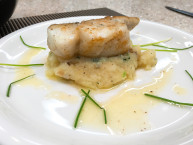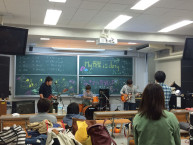If I were to summarize my experience with the Doshisha Animal Life circle into a single (albeit hyphenated) word, such a word would be “eye-opening.” From start to finish, I can say with sincerity that my opinion of Japanese culture, especially that of young people here, has drastically evolved from a generally positive yet uneducated perspective to a conflicted yet informed view on their lifestyles. Via my various interactions with said students (or lack thereof), I can conclude that Japanese students are passionate about their circles, but less so regarding new – read: foreign – members of these organizations.
When I entered my first two meetings alongside a friend from KCJS, I was initially stunned by the small size of the club. I would later find out that nearly no one at the University knew that my circle existed, which I likely should have researched before jumping into the fray. Regardless, the first couple meetings were attended by only a few people, and were fairly quiet. I was impressed, however, by the enthusiast manner in which I was greeted by the president of the organization, both electronically and personally. Via social networking, she expressed her excitement to meet both myself and my friend, and in person, she gifted to us small Japanese candies and confections. This, in conjunction with how kindly the other members reacted to our entrance, led to my initial hypothesis that Japanese university students were eager to accept foreign students into their midst. However, as I will elaborate upon later, this was the warmest response I received all semester. The first two meeting ended on disappointingly anticlimactic notes, as the members sat and discussed administrative manners for about an hour and a half for both sessions. Regardless, I was able to gather that university organizations here are held to a high standard of organization.
As the next few meetings passed, I began to observe a pattern in the students’ behavior: they would appear very excited to see us when we first joined the meeting, but after this initial excitement, would begin to divide into two distinct groups. Said groups consisted of the men, who did not attempt to make conversation with us, and the women, who attempted to keep us involved in the conversation but didn’t exactly succeed. However, it was the thought that counted in this situation, and it was appreciated. I began to hypothesize that a) perhaps Japanese students, especially the males, needed some time to adjust to foreign students entering their organization, and b) that Japanese university students are emotional and financially committed to their extracurricular activities – my friend and I were blown away when every single member of the organization purchased an optional custom sweater that was not exactly inexpensive, in order to support their circle’s financial state.
The next two weeks brought new realizations regarding Japanese student culture. I began to spot a striking similarity which the circle bore to Japanese corporate culture – the length of time needed to make executive decisions regarding the club’s future. As in Japanese corporations, this circle took awfully long to decide on the simplest matters, due to the necessity of having everyone’s consensus. In fact, so much time was spent on making decisions that, coming from an American perspective, not much progress was ever made during these meetings. On a brighter note, I was able to conclude that while not always inclusive, Japanese students remain unfailingly polite – although a community had yet to form between myself and the other members, I could always ask questions and felt comfortable speaking up.
As the organization’s first major event of the term drew nearer, a new ambience began to envelop the organization – that of intense, physical work. Finally, I began to see tangible results of the students’ decision-making, notably the creation of arts and crafts needed to make the circle’s booth at the event look its best. However, as with many aspects of Japanese society, this came with a caveat. Because the Japanese students began to enter a mode of tight focus as their plans came together, they began to speak less and less to each other during meetings, and naturally, less and less to myself and my friend. While I was using my meager art skills to help craft various decorations for the display, I would attempt to engage in conversation with a few people, only to be answered with brief responses. I began to hypothesize that though students seemed to chat frequently and openly during informational or planning meetings, work meetings were a time for just that, and not much else. Looking at the situation from a happier perspective, I noticed that the students were visibly pleased with work, either because a) I was a foreigner, and they didn’t exactly know what to expect, or b) they genuinely appreciated that I had done my best and admired the results. In all honesty, I had expected quite the opposite: large amounts of criticism until my work was perfect.
In the penultimate week of my Community Involvement Project and as my final meeting approaches, I feel that several of my former hypotheses stand true and are only strengthened by the experiences I have had with the members of the Doshisha Animal Life circle. As mentioned earlier, I stand by my belief that it is difficult for Japanese students to accept foreigners into the activities of their circles, let alone become close friends with them. This belief is only further solidified by one glaring disappointment: even though I participated in the preparation for the previous festival which the circle had a booth at (which I could not attend), I never received an invitation to participate in the largest circle event of the year – Doshisha Eve, at which I ran into the members in an uncomfortable situation. In fact, I was never actually informed that the organization would be participating in the event, leading me to the conclusion that perhaps I did not make clear my intentions for joining the circle upon first meeting its members. Stemming from this disappointment, I remain able to say that Japanese students, though passionate and dedicated to their circles (as can be seen by the Animal Life circle’s relentless attempts to sell its hot chocolate at Doshisha Eve, and large financial investments by nearly all its members) remain unsure of how to accept foreign students into their midst. In hindsight, I would have attempted to make my intentions of joining the circle quite clear upon first meeting the students, so as to avoid an awkward situation like that of Doshisha Eve. These intentions would include being involved in the students’ activities outside meeting times, so that I would be better able to observe these students in more relaxed settings. Regarding my experience holistically, there are many social aspects which I would have altered, but I believe that I benefitted from my experience educationally in that I was exposed to the intricacies of the deceiving culture of Japanese youth.


